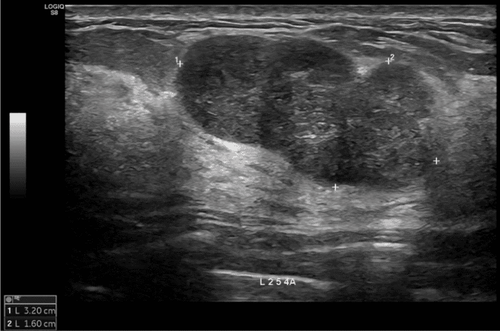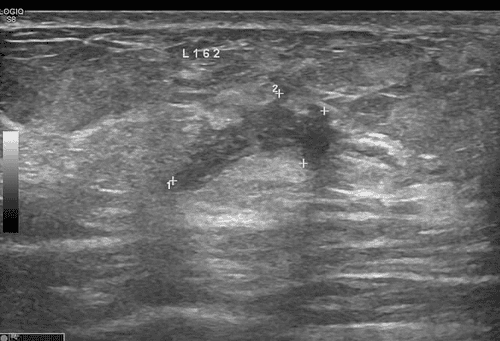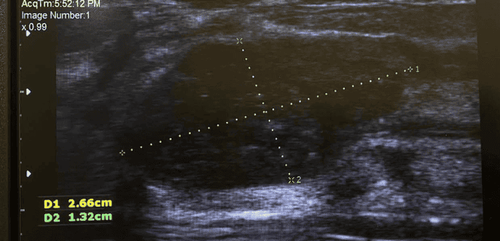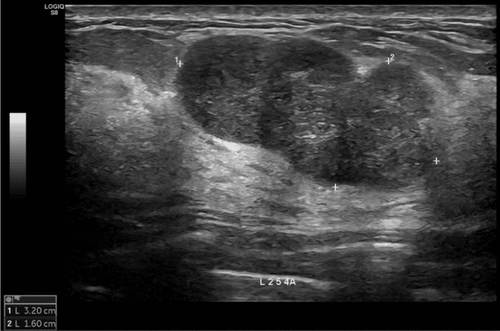Breast cancer is one of the most dangerous diseases in women with a high incidence and mortality rate. However, advances in medical technology have helped detect breast cancer early in the early stages, even at stage 0, when malignant cells have not yet shown signs of invasion. The story of patient T, 56 years old, is a typical example showing the important role of regular check-ups and mammography in early detection of breast cancer, helping to increase the chance of treatment and good prognosis.
Patient T did not experience any unusual symptoms in the chest area. However, because she was always concerned about her health, the patient went for a regular mammography at the Breast Center, Vinmec Times City International General Hospital in January 2024.
On the patient's mammography, doctors discovered a very small cluster of microcalcifications in the left breast that could not be seen on ultrasound. To ensure accuracy, doctors at the Breast Center compared the current image with the patient's X-ray results from two years ago and determined that this was a newly appeared lesion with a 10-50% chance of malignancy, even though the lesion was very small (only 5.4x2.1mm).
After identifying the microcalcification cluster via X-ray, doctors continued to order a magnetic resonance imaging (MRI) scan for a clearer view. Based on the MRI image, the image of the lesion absorbing contrast was larger, about 12x7mm, corresponding to the suspicious area on the X-ray. Through the imaging results, the doctor decided to perform a biopsy to accurately determine the nature of the lesion.
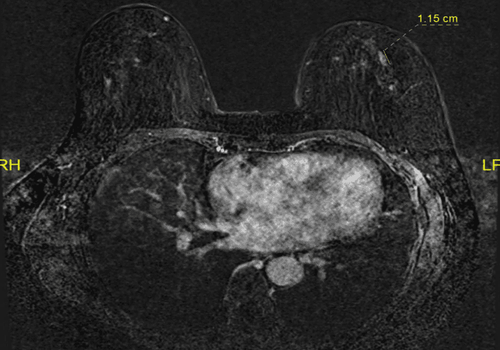
With modern biopsy techniques, a tissue sample in the small calcification area of only 5mm was removed and sent for histopathological analysis. The biopsy results showed that patient T had ductal carcinoma in situ (DCIS). This is a non-invasive cancer, when cancer cells are still localized in the wall of the mammary duct and have not spread to surrounding tissue areas. Thanks to early detection, Ms. T's prognosis is very good and the possibility of successful treatment is high. Ductal carcinoma in situ (DCIS) is one of the types of breast cancer with the most favorable prognosis and patients can avoid heavy, invasive treatments.
Ductal carcinoma in situ (DCIS) is a type of non-invasive breast cancer that is difficult to detect through clinical examination and does not form a clear mass, so patients often do not feel any signs. However, through X-ray, ductal carcinoma in situ can be detected as clusters of pleomorphic microcalcifications, which are often very small in size and easily overlooked if regular screening is not performed.
In recent years, with the development of imaging diagnostic methods, the detection rate of ductal carcinoma in situ has increased significantly. In the US, thanks to breast cancer screening, the incidence rate has increased from 1-2% to about 20% over the past 30 years. In Vietnam, the incidence of ductal carcinoma in situ currently accounts for about 4% of all breast cancer cases. However, early detection of the disease helps patients have a good prognosis, reduces invasive treatment and increases the 10-year survival rate to nearly 100%. Not only that, if treated early, it will reduce the risk of severe treatment such as total mastectomy, axillary lymph node dissection, radiotherapy or chemotherapy, reducing treatment costs and psychological impact on the patient.
For patient T, thanks to early detection at stage 0, the doctor proposed a conservative surgery option. Specifically, patients can undergo breast-conserving surgery without axillary lymph node dissection and most likely do not need postoperative chemotherapy. This helps to minimize the level of invasiveness, preserve aesthetics and limit complications, helping patients recover quickly and continue their daily lives.
It can be seen that the above patient's case is the clearest evidence of the benefits of regular check-ups and breast cancer screening through X-rays. Especially for people over 40 years old, even if there are no abnormal symptoms, annual mammography is very important. X-rays not only help detect breast cancer at an early stage but also increase the patient's prognosis and chances of successful treatment.




